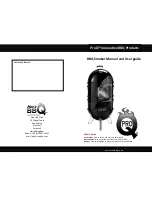
This alarm detects products of combustion using the ionisation technique. It contains
0.9 microcurie of Americium 241, a radioactive material (see Section 9).
Ionisation sensing alarms may detect invisible fire particles (associated with fast flaming
fires) sooner than photoelectric alarms. Photoelectric sensing alarms may detect visible
fire particles (associated with slow smoldering fires) sooner than ionisation alarms.
Home fires develop in different ways and are often unpredictable. For maximum
protection, Kidde recommends that both Ionisation and Photoelectric alarms be
installed.
This alarm is designed for installation by a qualified electrician, in accordance with
the latest I.E.E. Regulations and relevant British Standards.
This alarm must be installed by a competent person.
IMPORTANT! READ ALL INSTRUCTIONS. KEEP THIS MANUAL
NEAR THE ALARM FOR FUTURE REFERENCE.
CONTENTS OF THIS MANUAL
1 -- RECOMMENDED LOCATIONS FOR ALARMS
2 -- LOCATIONS TO AVOID
3 -- OPERATION AND TESTING
4 -- NUISANCE ALARMS
5 -- MAINTENANCE
6 -- LIMITATIONS OF SMOKE ALARMS
7 -- GOOD SAFETY HABITS
8 -- NRPB INFORMATION
9 -- KIDDE RECOMMENDATIONS
10 -- SERVICE AND WARRANTY
ENVIRONMENTAL PROTECTION
Waste electrical products should not be disposed of with household waste.
Please recycle where facilities exist. Check with Local Authority or retailer
for recycling advice.
1. RECOMMENDED LOCATIONS FOR ALARMS
• Locate the first alarm in the immediate area of the sleeping rooms. Try to monitor the
exit path as the sleeping rooms are usually farthest from the exit. If more than one
sleeping area exists, locate additional alarms in each sleeping area.
• Locate additional alarms to monitor any stairway as stairways act like chimneys for
smoke and heat.
• Locate at least one alarm on every floor level.
• Locate an alarm in every sleeping room.
• Locate an alarm in every room where electrical appliances are operated (i.e. portable
heaters or humidifiers).
• Locate an alarm in every room where someone sleeps with the door closed.
The closed door may prevent an alarm not located in that room from waking the
sleeper.
• Smoke, heat, and combustion products rise to the ceiling and spread horizontally.
Mounting the smoke alarm on the ceiling in the center of the room places it closest
to all points in the room. Ceiling mounting is preferred in ordinary residential
construction.
• When mounting an alarm on the ceiling, locate it at a minimum of 10 cm (4”) from
the side wall. (see Figure 1).
0910-7218-01(21008412B)_v1.qxd:_ 2011.10.27 12:35 PM Pag



























